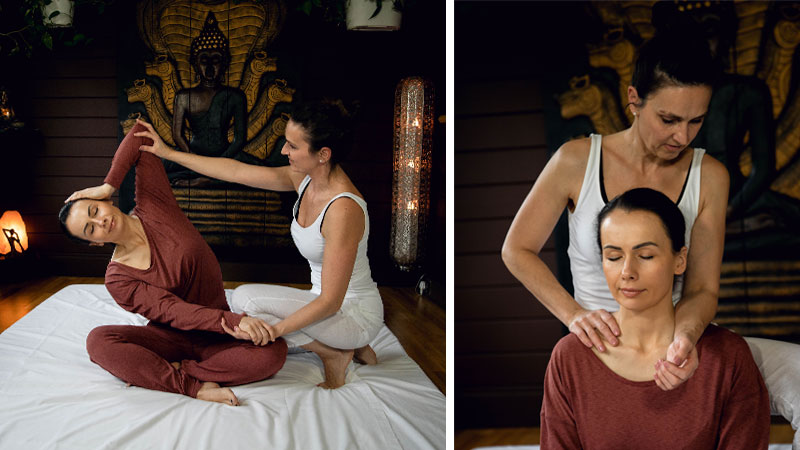Thai Yoga Massage
Traditional Thai Yoga massage uses no oils or lotions. You will remain fully dressed throughout the treatment, so you should choose fitted but comfortable clothing. The treatment is performed on a cotton covered memory foam mat on the floor. As an alternative, I can use shiatsu cushions which allow your head to face downwards like on a massage couch. Less mobile people often find this method more comfortable.
Contrary to popular preconceptions, Thai Yoga Massage does not require you to be flexible, athletic or strong. Each treatment is designed to suit client needs. As the basic principle is to balance the energy in the body with palming and thumbing techniques, this form of body work can be done on anyone: young, old, healthy or unwell.
Wonderful yoga-based stretches are secondary and do not need to be integral to the treatment. However, for those able to receive them, these effective and beautiful stretches really enhance the experience and benefits.
The sequences of stretching and pressure work are given in a smooth, unhurried and harmonious way with one move dissolving into the next; this generates a feeling of deep relaxation and balance within your body. Thai Yoga Massage is always practised in a meditative mood. It is said to be “the physical application of loving kindness”.
Traditional Thai Yoga is widely considered to be a medical discipline used for the treatment of a wide variety of ailments. It is a holistic treatment, an interactive manipulation of the body using passive stretching and gentle pressure. Thai massage helps to strengthen the body and increase flexibility, while allowing the client to benefit from the relaxation and healing properties of massage.
This treatment is both relaxing and energising and is modified specifically to meet your body’s needs and capacities. I may use hands, elbows or feet to apply pressure to certain energy points, and gentle stretches to help you achieve shifts in body alignment to release blocked energy and free the body’s healing potential, restoring balance and harmony.
A typical session is 2 hours, although a good treatment can take only 1.5 hours if it needs to be shorter.
BOOK ONLINE

What Thai Massage is
Traditional Thai Massage is an ancient form of body therapy, which incorporates both yoga and acupressure techniques. With gentle rocking, deep stretching and compressions it assists in the natural rebalancing of your muscular-skeletal framework. Known as “lazy man’s yoga” you will feel invigorated and centred after a treatment.
Thai yoga massage works to clear energy blockages and restore balance and harmony to the body.
The technique used is the technique of ASOKANANDA. Asokananda (Harald Brust) was born in 1955 in West Germany. Since 1978 he spent most of his time in Asia, where he was involved in the research into and teaching of yoga, Buddhist meditation and traditional Thai yoga massage.
“When any person is sick at Siam he begins with causing his whole body to be moulded by one who is skilful herein, who gets upon the body of the sick person and tramples him under his feet.”
– Simon de la Loubere, French liaison to the Thai Royal Court in Ayutthia, 1690
Traditional Thai massage can look back at a long history of therapeutic healing. The earliest roots of Thai massage lie not in Thailand but in India. The legendary founder of the art is believed to have been a doctor from northern India. Known as Jivaka Kumar Bhaccha, he was a contemporary of the Buddha and personal physician to the Magadha King Bimbisara over 2,500 years ago.
The theoretical foundation of Thai massage is based on the concept of invisible energy lines running through the body. Ten of these lines are especially important in Thai massage: ‘The 10 Sen’ or sib sen. The Indian origin and influence becomes obvious here since the background of this theory clearly lies in Yoga philosophy.
The 10 Sen are sufficient to conduct practical treatment for the whole body and its internal organs. Western scientists are still puzzled by the fact that these lines and points do seem to have validity. These points can be thought of as ‘windows’ into the body. Working on the energy lines with massage can break the blockades, stimulate the flow of Prana (life energy), and help to restore well-being.
Thai massage differs radically from ‘Swedish Massage’ which is the most widespread technique of massage in the West. Physiotherapy and chiropractic in the West are closer to Thai massage than Swedish massage is, but these techniques also ignore manipulating the energy points and the energy flow of the body.
